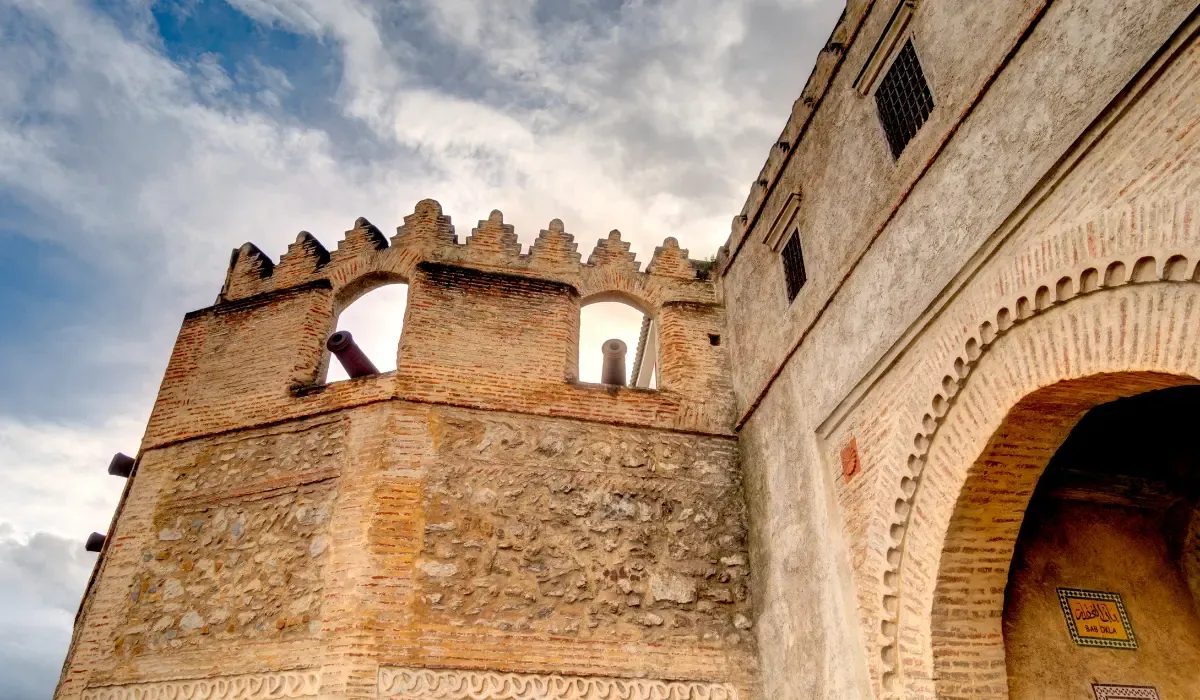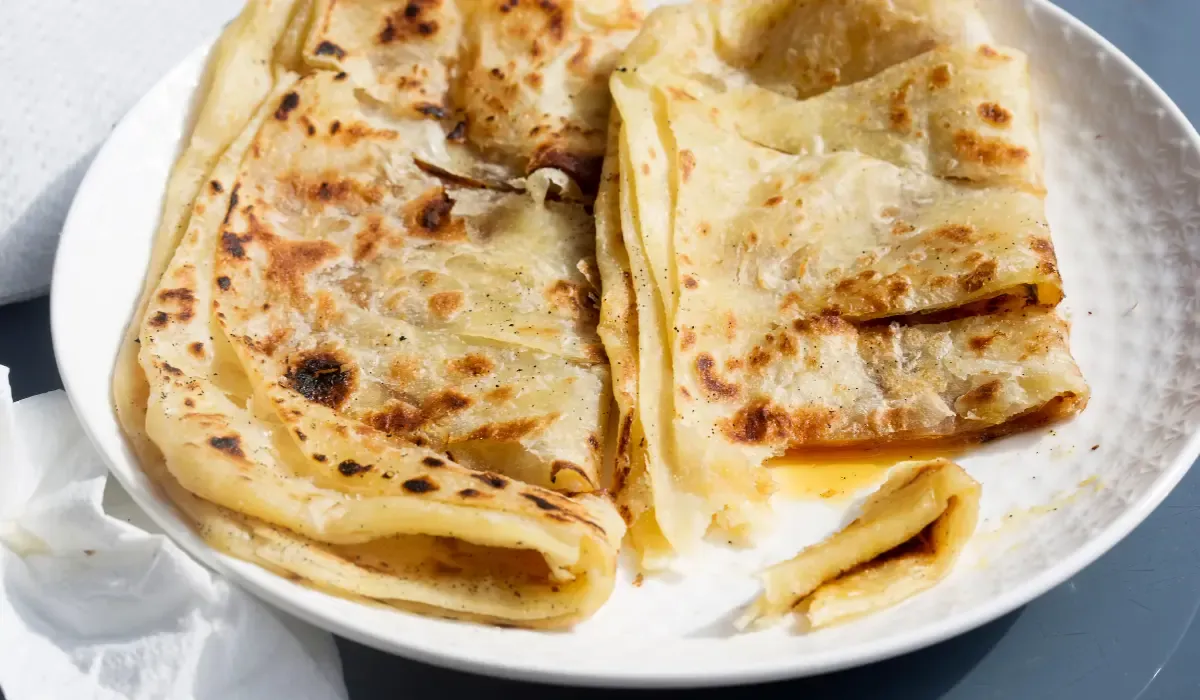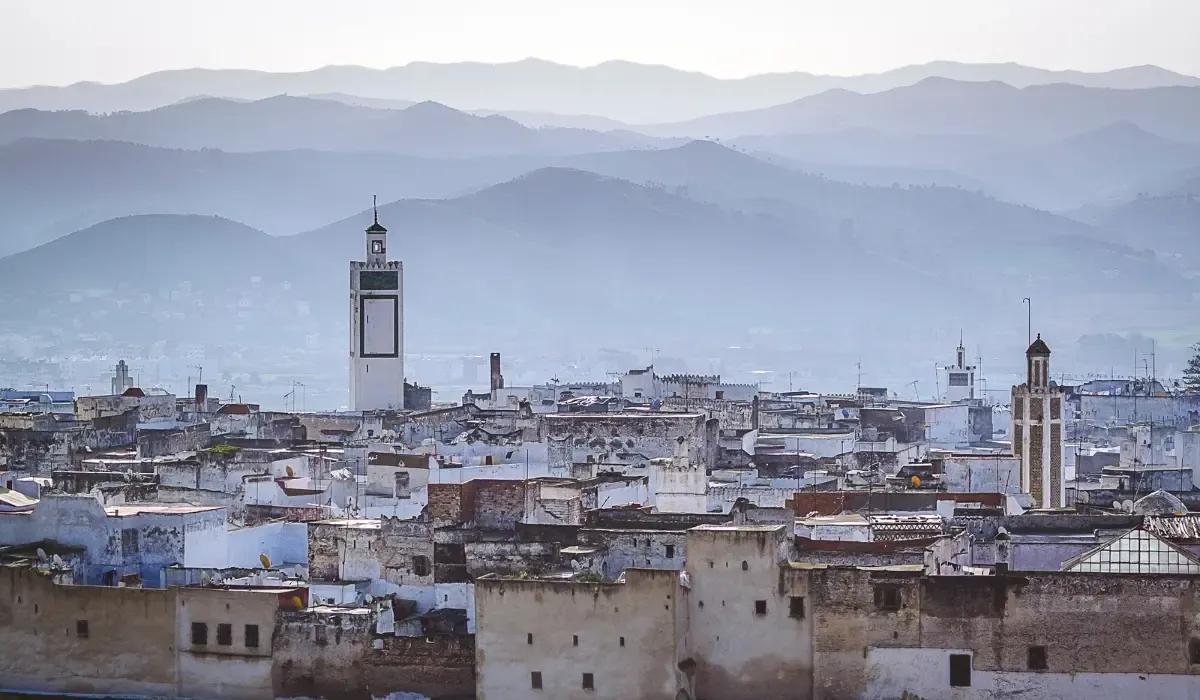Tetouan: The White Dove
Discover the Andalusian-inspired gem of northern Morocco
Culinary Delights

Must-Try Specialties
- Tetouan Pastilla - Chicken and almond pie
- Rfissa - Traditional celebratory dish
- Tetouan Harira - Unique local version
- Mrouzia - Honey and raisin lamb
- Kaabia - Local sweet pastries
- Mint Tea - Tetouan-style preparation
Cultural Treasures

Heritage & Landmarks
Explore Tetouan's UNESCO-listed medina with its distinctive whitewashed buildings and Andalusian architectural influences...
Top Attractions
- The Medina - UNESCO World Heritage Site
- Escuela de Artes y Oficios - Art school
- Fish Market - Vibrant local market
- Kasbah - Historic fortress
- Museum of Moroccan Arts - Cultural treasures
- Mechouar Square - Social heart of the city
- Jewish Quarter - Historic Mellah
City Map
Perched between the rugged Rif Mountains and the sparkling Mediterranean Sea, Tetouan enjoys a breathtaking natural setting in northern Morocco. Located just 60 km east of Tangier and 40 km south of the Spanish coast, the city has long been a cultural crossroads between Africa and Europe. Its strategic position near Ceuta (a Spanish enclave) and the coastal town of Martil makes it a gateway to both mountain adventures and seaside escapes. The nearby Talassemtane National Park offers stunning hiking trails, while the Mediterranean beaches provide sun-soaked relaxation.
Andalusian Jewel

Medina Living & Culture
Tetouan shines as Morocco's Andalusian gem, boasting stunning whitewashed architecture and a vibrant artisan tradition. The city features historic landmarks like the Spanish Mosque, the Royal Palace, and the iconic Hassan II Square. As the gateway between Morocco and Andalusia, it offers cultural attractions including the Archaeological Museum and the UNESCO-listed medina. Tetouan blends Andalusian influences with Moroccan traditions through its picturesque alleys, historic houses, and authentic markets.
Traditional Kitchens in Tetouan

Andalusian Kitchen Designs
Tetouan's traditional kitchens showcase a harmonious blend of Andalusian elegance and Moroccan craftsmanship. Signature elements include:
- Whitewashed walls with blue accents
- Hand-painted ceramic tiles with floral patterns
- Wood-fired ovens for traditional bread baking
- Brass and copper cookware
- Open courtyard kitchens with natural light
As Morocco's Andalusian capital, Tetouan features unique kitchen designs in its historic homes that have preserved culinary traditions while adapting Spanish influences.
Tetouan's Signature Dishes
Experience the Andalusian flavors of Tetouan through its most celebrated specialties

Tetouani Pastilla
The unique chicken and almond pie with a touch of cinnamon, wrapped in delicate pastry, showcasing Tetouan's Andalusian influences.
View Recipes →
Tetouani Mrouzia
Lamb slow-cooked with honey, raisins and spices, traditionally served during Eid al-Adha celebrations in Tetouan.
View Recipes →
Tetouani Harira
The rich tomato and lentil soup with a unique Tetouani twist, featuring local spices and herbs, traditionally served to break the fast.
View Recipes →
Tagine Tetouani
Tetouan's famous fish tagine with preserved lemons and olives, reflecting the city's coastal location and Andalusian influences.
View Recipes →
Tetouani Bocadillos
Spanish-inspired sandwiches filled with grilled meats or fish, a popular street food in Tetouan's markets.
View Recipe →
Tetouani Sweets
Delicate pastries like kaab el ghzal and fekkas, showcasing Tetouan's unique blend of Moroccan and Andalusian patisserie traditions.
View Recipe →
Founded by Andalusian refugees in the 15th century, Tetouan is a city where Moroccan and Spanish influences blend seamlessly. Its UNESCO-listed medina, with whitewashed walls and blue accents, feels like a smaller, more intimate version of Chefchaouen.
The city’s Moorish architecture, ornate fountains, and hidden courtyards reflect its history as the last stronghold of Al-Andalus in Morocco. Unlike more touristy cities, Tetouan retains an authentic, unhurried charm, where artisans still craft hand-painted ceramics, embroidery, and lute instruments using centuries-old techniques.
Tetouan is a haven for artists and food lovers alike. The city’s Dar Sanaa Art School preserves traditional Andalusian music and calligraphy, while its cinema festival attracts filmmakers from across the Arab world.
The culinary scene is equally rich—savor pastela tetouania (a local take on the savory-sweet pie), seafood bastilla, or Rif Mountain honey drizzled over fresh goat cheese. The Spanish Quarter adds a European flair with tapas bars and colonial-era cafés, making Tetouan a delicious fusion of flavors.

Tetouan’s cuisine is a delicious testament to its rich history as a cultural crossroads. Influenced by its Andalusian roots, Spanish heritage, and Berber traditions, the city offers a unique gastronomic identity unlike anywhere else in Morocco.
Tetouan’s cuisine is a journey through time—where Moorish spices, Mediterranean freshness, and mountain Berber traditions come together in every bite.
Whether in a bustling souk or a seaside terrace, dining here is an unforgettable cultural experience.
Tetouan's Authentic Street Food
Discover the Andalusian-Inspired Street Food Culture of Tetouan's White Medina

Tetouani Msemen
Tetouan's version of the flaky, layered pancakes has a distinct Andalusian influence, often served with olive oil and honey or stuffed with spicy sardines. Found throughout the white medina, the best versions are cooked in the Mellah district, where the technique reflects the city's Jewish culinary heritage.
View Recipes →
Tetouani Harira
Tetouan's version of the classic soup includes chickpeas, lentils, and a unique blend of spices reflecting Andalusian influences. Unlike other regions, Tetouani harira often includes seafood. The best versions can be found near the Hassan II Square during Ramadan evenings.
View Recipes →
Tetouani Seafood Brochettes
Reflecting its coastal location, Tetouan specializes in seafood skewers - especially swordfish and prawns marinated in chermoula. The most famous vendors are found near the fish market, where the catch comes directly from the Mediterranean. Served with lemon and harissa.
View Recipe →
Tetouani Andalusian Sweets
Tetouan is famous for its Spanish-influenced pastries like pestiños (honey-coated fritters) and mantecados (shortbread cookies). The best sweet shops cluster around the Spanish Quarter, where recipes blend Moroccan and Andalusian techniques. Don't miss the orange blossom-scented kaab el ghzal.
View Recipe →
Tetouani Tapas
Reflecting its Spanish influence, Tetouan has a vibrant tapas culture. Small plates like gambas al ajillo (garlic shrimp), boquerones (marinated anchovies), and berenjenas con miel (fried eggplant with honey) are served in cafes around the Plaza Primo. Perfect with a glass of mint tea or local wine.
View Recipes →
Tetouani Mint Tea
Tetouan's tea culture blends Moroccan and Spanish traditions. The tea is served in glass cups rather than traditional glasses, often with pine nuts floating on top. The tea stalls near the Royal Palace are famous for their ceremonial pouring style and accompanying almond cookies.
View Recipe →
Tetouani Bocadillos
These Spanish-style sandwiches are a Tetouan street food staple, filled with ingredients like tortilla española (potato omelet), grilled sardines, or chorizo. The best are found in the modern city near the Spanish consulate, where they're served on crusty baguettes with harissa and olives.
View Recipes →SOME TIPS FOR EXPERIENCING MOROCCAN CUISINE IN TETOUAN:
1. Taste Andalusian-Inspired Dishes
Tetouan's cuisine is heavily influenced by its Moorish-Andalusian heritage. Try:
- Pastilla Tetouania - A savory-sweet pie with chicken or seafood, distinct from Fes' version
- Briouat - Crispy stuffed pastries with meat or cheese
- Hout Quari'a - Spicy fish balls in tomato sauce
2. Explore the Historic Medina's Food Scene
Wander through Plaza Hassan II and nearby alleys to find:
- Fresh seafood stalls (try grilled sardines or fried calamari)
- M'semen & Harcha - Local pancakes perfect with honey or olive oil
- Olive & pickle vendors (Tetouan is famous for its preserved foods)
3. Visit the Old Medina's Food Markets
Explore these vibrant markets:
- Souk El Attarine (spice market) for aromatic blends
- Souk Nejjarine for traditional woodcrafts and snacks
- Sample Bissara (creamy fava bean soup), a local breakfast favorite
4. Visit a Traditional Market (Souk)
- Souk El Houts (Fish Market): Try Chermoula-marinated fish
- Souk El Fouki: For spices and Tetouan's signature green olives
5. Try Tetouan's Unique Breads
- Fougasse Tetouania - Soft, anise-flavored bread with olive oil
- Matloue - Fluffy round bread perfect for sandwiches
6. Sip Coffee or Mint Tea in a Historic Café
- Relax at Café Madrid or Café Oumara for traditional Moroccan coffee with a Tetouani twist
Tetouan's food blends Moroccan, Spanish, and Andalusian flavors—perfect for an off-the-beaten-path culinary adventure!
TOURISM IN TÉTOUAN

Things to Do in Tetouan
Discover Morocco's Andalusian gem with its unique white medina and cultural attractions

Tetouan Medina
Tetouan's whitewashed medina, a UNESCO World Heritage site, is one of Morocco's most well-preserved Andalusian-style old towns. Wander through its narrow blue-and-white streets filled with artisan workshops and traditional houses reflecting Spanish-Moorish architecture.
Know more +
Royal Palace
The impressive Dar el Makhzen features stunning Hispano-Moorish architecture with seven golden gates. While the interior isn't open to the public, visitors can admire the magnificent facade and beautiful gardens in the Hassan II Square.
Know more +
Archaeological Museum
Housed in a beautiful former fortress, this museum showcases artifacts from Morocco's ancient Roman sites like Lixus and Tamuda. Highlights include mosaics, ceramics, and jewelry that reveal the region's rich pre-Islamic history.
Know more +
Spanish Mosque
This picturesque abandoned mosque on a hilltop offers the best panoramic views of Tetouan. Built during the Spanish protectorate, it's particularly magical at sunset when the white city glows pink against the Rif Mountains.
Know more +
(Mellah)
Tetouan's well-preserved quarter dates back to the 15th century when Sephardic Jews fled Spain. Explore the narrow streets, visit cemetery, and see the former homes of wealthy Jewish merchants with their distinctive balconies.
Know more +GEOGRAPHY & LOCATION
Tetouan is a coastal city in northern Morocco, nestled between the Rif Mountains and the Mediterranean Sea.
- Coordinates: 35°34′N 5°22′W
- Area: 120 km² (46 sq mi)
- Elevation: 90 m (295 ft)
DEMOGRAPHICS
Tetouan is a mid-sized city with strong Andalusian influences.
- City population: 380,000
- Metro population: 550,000
- Population density: 3,166/km²
- Growth rate: 1.8% annually
CLIMATE & WEATHER
Tetouan has a Mediterranean climate with mild winters and warm summers:
- Summer (Jun-Sep): 20-30°C (68-86°F), dry
- Winter (Dec-Feb): 8-18°C (46-64°F), rainy
- Annual rainfall: 800 mm (31 in)
- Record high: 42°C (108°F)
CULTURE & LANGUAGES
Tetouan has a unique blend of Moroccan and Andalusian culture.
- Primary language: Moroccan Arabic (Darija)
- Local language: Tetouani Arabic dialect
- Religions: Predominantly Muslim (98%)
- Cultural mix: Andalusian, Arab, Amazigh, Spanish influences
ECONOMY & CURRENCY
Tetouan's economy is based on fishing, agriculture, and tourism.
- Currency: Moroccan Dirham (MAD)
- Key industries: Fishing, citrus fruits, tourism
- Major exports: Seafood, oranges, handicrafts
- GDP contribution: ~3% of national GDP
TRANSPORTATION
Tetouan has good transportation links to other Moroccan cities:
- Sania Ramel Airport (TTU): 6km from city
- CTM buses: Connections to major cities
- Trains: Connection via Tangier (40km away)
- Taxis: Petit taxis (city) and grand taxis (intercity)
- Medina: Pedestrian-friendly with narrow alleys
Key Highlights of Tetouan:
UNESCO-listed white medina with Andalusian architecture
Gateway to beautiful Mediterranean beaches like Martil and Cabo Negro
Center of Andalusian-influenced arts and handicrafts
Famous for its seafood and Spanish-Moroccan fusion cuisine
Tetouan: Morocco's Andalusian Gem
Discover the white city with Spanish-Moorish charm
Geography & Location
Tetouan is beautifully situated between the Rif Mountains and Mediterranean coast.
- Coordinates: 35°34′N 5°22′W
- Area: 120 km² (46 sq mi)
- Elevation: 90 m (295 ft)
- Medina area: 50 hectares
Climate & Weather
Tetouan enjoys a pleasant Mediterranean climate with mild winters.
- Average temperature: 19°C (66°F)
- Summer highs: 28-32°C (82-90°F)
- Winter lows: 8-12°C (46-54°F)
- Annual rainfall: 800 mm (31 in)
Cultural Highlights
Tetouan blends Moroccan and Andalusian influences beautifully.
- White Medina - UNESCO World Heritage
- Royal Palace with golden gates
- Archaeological Museum
- Spanish Mosque - Panoramic views
Culture & Heritage
A unique blend of Moroccan and Andalusian traditions.
- Strong Spanish cultural influences
- Center of Andalusian music
- Historic Jewish quarter (Mellah)
- Famous for seafood cuisine
Economy & Industry
Tetouan's economy thrives on fishing, agriculture and tourism.
- Fishing and seafood processing
- Citrus fruit production
- Andalusian-style handicrafts
- Growing coastal tourism
Transportation
Tetouan is well-connected to northern Morocco and Spain.
- Sania Ramel Airport (TTU)
- Bus connections to Tangier (40km)
- Ferry to Spain from nearby ports
- Compact medina walkable
Why Visit Tetouan?
UNESCO-listed white medina with Andalusian charm
Gateway to beautiful Mediterranean beaches
Unique blend of Moroccan and Spanish culture
Famous for its fresh seafood cuisine
Key Information
Tetouan is northern Morocco's cultural gem with strong Andalusian influences, founded in the 15th century. With about 380,000 residents, it's known for its white medina and Spanish-Moorish architecture.
- Population: ~380,000
- Area: 120 km²
- Time Zone: GMT+1
- Currency: Moroccan Dirham (MAD)
Main Attractions
Tetouan offers unique Andalusian-Moroccan architecture and coastal beauty.
- White Medina - UNESCO site
- Royal Palace (Dar el Makhzen)
- Archaeological Museum
- Spanish Mosque viewpoint
- Martil Beach - 10km away
Transportation
Tetouan has good connections to northern Morocco and Spain.
- Sania Ramel Airport (TTU)
- Bus connections to Tangier
- Ferries to Spain from nearby ports
- Petit taxis for city travel
- Compact medina walkable
Why Visit Tetouan?
UNESCO-listed white medina
Beautiful Mediterranean beaches
Unique Andalusian-Moroccan art
Excellent seafood cuisine
Center of Andalusian music
Rich Spanish-Moroccan history











%20(1).webp)
.webp)


.webp)

